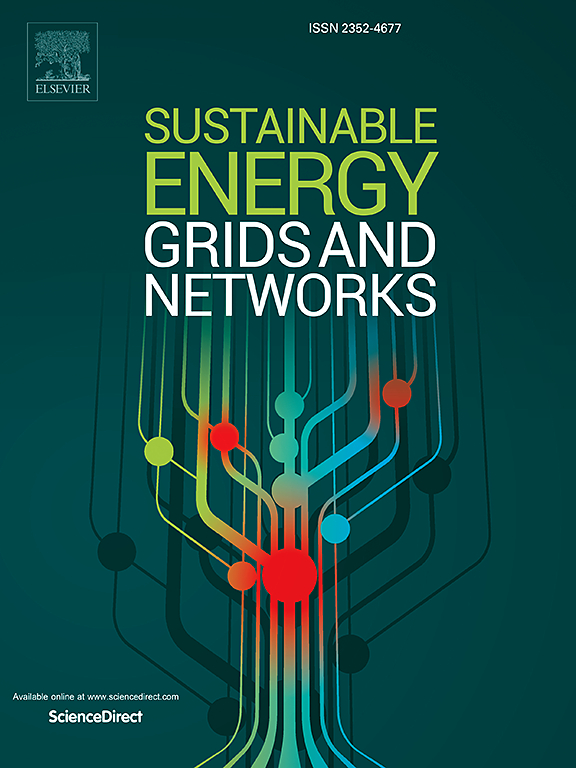为下一代港口码头的分散化及解除管制运作而设计的多主体能源管理架构
IF 5.6
2区 工程技术
Q2 ENERGY & FUELS
引用次数: 0
摘要
未来港口的能源消耗预计将相当可观,因此需要仔细的资源管理,以确保盈利和碳中和。本文探讨了在大型复杂的海港系统中,在多个主体(即码头运营商、港务局和电网)之间实施新的能源管理框架(EMF)的可能性。该EMF的主要目标是通过公平分配内部分布式能源资源(DERs)来降低港务局的总体能源采购成本,同时提供更好的计算可扩展性、信息隐私和通信网络安全。为了实现这一目标,首先,根据代理的操作时间、灵活性和功率级别对不同的der进行一般的分析。其次,建立了乘数驱动的局部能源市场(LEM)的交替方向方法,以分散的方式有效管理终端之间可用der的盈余和不足。然后,利用一种独特的动态惩罚机制,通过减少代理之间的通信轮数来提高ADMM的收敛速度。提议的EMF的可行性和盈利能力在多个方面与传统建立的框架进行了系统的比较。仿真是在MATLAB编程平台和Gurobi优化求解器上进行的,利用了一个实际端口的修改操作数据。得到的结果表明,所提出的分散多智能体LEM模型可以通过公平利用内部分布式资源而不共享智能体的机密信息,以接近集中式LEM模型的结果出清市场。此外,启发式变化的动态惩罚将迭代计数减少到510(190秒),而传统EMF的迭代次数为1800(1110秒),这增加了攻击者获取机密信息的难度。因此,提议的EMF可以被认为(1)有利于管理端口的der,(2)防止任何短期网络攻击。本文章由计算机程序翻译,如有差异,请以英文原文为准。
A multi-agent energy management framework for decentralised and deregulated operation of next-generation port terminals
Energy consumption in future ports is expected to be quite significant and therefore necessitates careful resource management to ensure profitability and carbon neutrality. This paper explores the possibility of implementing a new energy management framework (EMF) among multiple agents—namely, terminal operators, port authority, and the grid—within a large and complex seaport system. The primary objective of this EMF is to reduce overall energy procurement costs for the port authority through a fair allocation of internal distributed energy resources (DERs) while providing better computational scalability, information privacy, and communication cybersecurity. To achieve this goal, first, dissimilar DERs available with the agents are generically profiled based on their operation time, flexibility and power level. Second, an alternating direction method of multipliers (ADMM)-driven local energy market (LEM) is established to efficiently manage the surplus and deficit of available DERs among the terminals in a decentralised manner. Then, a unique dynamic penalty mechanism is utilised to enhance the ADMM’s convergence speed by reducing the number of communication rounds among agents. The feasibility and profitability of the proposed EMF are systematically compared on multiple fronts against traditionally established frameworks. The simulations are carried out on the MATLAB programming platform and the Gurobi optimisation solver, utilising a real port’s modified operational data. The obtained results have shown that the proposed decentralised multi-agent LEM model can clear the market with outcomes closely comparable to those of the centralised LEM model, and this is achieved through a fair utilisation of the internal distributed resources without sharing the agents’ confidential information. Further, the heuristically varying dynamic penalty has reduced the iteration count to 510 (190 s), compared to 1800 iterations (1110 s) in conventional EMF, which increases difficulty for an attacker in obtaining confidential information. Therefore, the proposed EMF can be considered (1) beneficial for the management of the port’s DERs and (2) secure against any short-term cyber attacks.
求助全文
通过发布文献求助,成功后即可免费获取论文全文。
去求助
来源期刊

Sustainable Energy Grids & Networks
Energy-Energy Engineering and Power Technology
CiteScore
7.90
自引率
13.00%
发文量
206
审稿时长
49 days
期刊介绍:
Sustainable Energy, Grids and Networks (SEGAN)is an international peer-reviewed publication for theoretical and applied research dealing with energy, information grids and power networks, including smart grids from super to micro grid scales. SEGAN welcomes papers describing fundamental advances in mathematical, statistical or computational methods with application to power and energy systems, as well as papers on applications, computation and modeling in the areas of electrical and energy systems with coupled information and communication technologies.
 求助内容:
求助内容: 应助结果提醒方式:
应助结果提醒方式:


